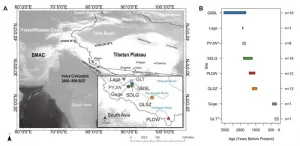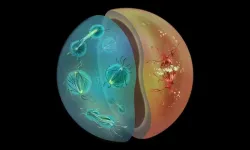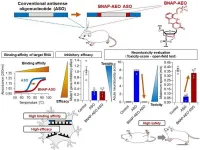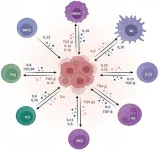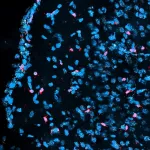(Press-News.org)
Cell division is fundamental to life, enabling growth, reproduction, and survival across all organisms, from single-celled bacteria to complex multicellular animals. While animals and fungi share a common eukaryotic ancestry, their mechanisms of cell division, particularly mitosis, have diverged significantly, raising intriguing evolutionary questions.
Animals typically undergo open mitosis, where the nuclear envelope disassembles during cell division, while fungi exhibit closed mitosis, maintaining an intact nuclear envelope. The evolutionary reasons behind these divergent strategies remain largely unexplored, making it a compelling area of research for scientists seeking to understand the underlying biological principles.
In a new study, Omaya Dudin's group at EPFL, Gautam Dey and Yannick Schwab's team at EMBL Heidelberg investigated this phenomenon in the Ichthyosporea, a group of marine protists that are closely related to both animals and fungi (a protist is a eukaryotic organism that is not an animal, land plant, or fungus). Dudin is an expert in Ichthyosporean life cycles, while Dey’s research focuses on the evolutionary origins of nuclear organization and cell division
The scientists focused on two species of Ichthyosporea: Sphaeroforma arctica and Chromosphaera perkinsii. The research combined comparative genomics and advanced imaging techniques, such as Expansion Microscopy and Volume Electron Microscopy, to examine how these species’ life cycles influenced their modes of cell division. S. arctica was observed to undergo closed mitosis, similar to fungi, while C. perkinsii performed open mitosis, akin to animal cells.
“By studying diversity across organisms and reconstructing how things evolved, we can begin to ask if there are universal rules that underlie how such fundamental biological processes work,” says Dey.
The study found a clear link between the life cycle stages of Ichthyosporea and their mitotic strategies. Species with multinucleate stages, where cells contain multiple nuclei, tended to undergo closed mitosis. Conversely, species with predominantly mononucleate stages – single nuclei per cell – used open mitosis. This correlation suggests that the evolutionary path of cell division in animals and fungi may have been shaped by their respective life cycle needs.
“Ichthyosporean development displays remarkable diversity,” says Dudin. “On one hand, several species exhibit developmental patterns similar to those of early insect embryos, featuring multinucleated stages and synchronized cellularization. On the other hand, C. perkinsii undergoes cleavage division, symmetry breaking, and forms multicellular colonies with distinct cell types, similar to the ‘canonical view’ of early animal embryos. This diversity not only helps in understanding the path to animals but also offers a fascinating opportunity for comparative embryology outside of animals, which is, in itself, very exciting.”
The findings suggest that the way animal cells divide might have evolved long before the emergence of animals themselves. Meanwhile, the mode of mitosis appears to be intricately connected to the organism's life cycle, which opens up new perspectives on the evolution of cell division mechanisms in eukaryotes.
Other contributors
EMBL Electron Microscopy Core Facility
Ruđer Bošković Institute (RBI)
University of Groningen
Reference
Hiral Shah, Marine Olivetta, Chandni Bhickta, Paolo Ronchi, Monika Trupinić, Eelco C. Tromer, Iva M. Tolić, Yannick Schwab, Omaya Dudin, Gautam Dey. Life-cycle-coupled evolution of mitosis in close relatives of animals. Nature 22 May 2024. DOI: 10.1038/s41586-024-07430-z
END
The inflorescence architecture of crop plants like barley is predominantly regulated by meristem activity and fate, which play a critical role in determining the number of floral structures for grain production. Spikelets are the basic reproductive unit of grass inflorescences. The identity and determinacy of many grass meristems are partially determined by a group of genes expressed specifically at organ boundaries, which can form local signalling centres that regulate adjacent meristem fate and activity.
These genes are critical for establishing and ...
According to a study published in Current Biology on May 22, the genetic components of the ancient populations in the western Tibetan Plateau are closest to ancient populations in the southern Tibetan Plateau, and their major genetic components have been maintained over the past 3,500 years. In addition, these ancient populations in the western Tibetan Plateau had complex and frequent interactions with ancient populations inside and outside the plateau.
The study was conducted by Prof. FU Qiaomei's team from the Institute of Vertebrate Paleontology and Paleoanthropology ...
Cell division is one of the most fundamental processes of life. From bacteria to blue whales, every living being on Earth relies on cell division for growth, reproduction, and species survival. Yet, there is remarkable diversity in the way different organisms carry out this universal process. A new study from EMBL Heidelberg’s Dey group and their collaborators, recently published in Nature, explores how different modes of cell division evolved in close relatives of fungi and animals, demonstrating, for the first time, the link between an organism’s ...
Researchers from Tokyo Medical and Dental University (TMDU) and Osaka University find that a newly developed modified sugar increases the efficacy and safety of antisense oligonucleotides designed to treat central nervous system disease
Tokyo, Japan – Diseases that affect the brain and spinal cord can be particularly devastating, and finding new and more effective ways to treat these conditions is an important goal for researchers and clinicians alike. Now, a research group from Japan reports that slightly modifying an existing treatment for central nervous system (CNS) disease dramatically increases its ...
Hepatocellular carcinoma (HCC), a prevalent form of cancer, profoundly influences the progression and prognosis of the disease through immune response mechanisms. The tumor microenvironment plays a pivotal role in fostering immune suppression and maintaining self-tolerance, which are crucial in developing and refining immunotherapy approaches.
In our comprehensive review, we initially delve into the characteristics of the tumor microenvironment in HCC, elucidating the predominant immunosuppressive mechanisms at play and the biomarkers pivotal for tracking the disease progression and therapeutic ...
Boulder, Colo., USA: Chevron, a leading energy corporation committed to supporting educational initiatives in the geosciences, has announced a partnership with the Geological Society of America (GSA) to provide field trip grants, beginning with the organization’s annual meeting, GSA Connects 2024. This year’s meeting will take place in Anaheim, California, USA, 22–25 September.
The GSA/Chevron Field Trip Grant aims to support students or early career professionals in attending field trips during GSA Connects. GSA’s field trips provide valuable hands-on learning experiences, networking opportunities, ...
Since cannabidiol (CBD), the non-intoxicating component of cannabis, was legalized in the United States by the 2018 Farm Bill, products containing the compound have flooded the consumer health sector. While there is a single FDA-approved medication containing CBD which can be used to treat rare forms of epilepsy, evidence for the efficacy of commercial CBD products, which generally contain low doses of CBD, is limited. However, this has not stopped their widespread and growing use.
Now, a new study published in Cannabis ...
No parent wants to risk their child having a serious infection, least of all while still in the womb, but did you know that the immune response to a viral infection during pregnancy could also affect the development of the unborn offspring? Scientists from Harvard University in Cambridge, USA, have shown that immune reactions in pregnant mice are detected by a specific type of brain cell in the developing embryo and alter how genes are regulated in the brain – a change that persists in juvenile mice. Published today in the journal Development, this study provides ...
Many countries around the world are considering revising cannabis policies. A new study by a researcher at Carnegie Mellon University assessed cannabis use in the United States between 1979 and 2022, finding that a growing share of cannabis consumers report daily or near-daily use and that their numbers now exceed those of daily and near-daily alcohol drinkers. The study concludes that long-term trends in cannabis use parallel corresponding changes in policy over the same period. The study appears in Addiction.
“The data come from survey self-reports, but the enormous changes in ...
New York, NY – The American Federation for Aging Research (AFAR), a national non-profit organization whose mission is to support and advance healthy aging through biomedical research, is pleased to recognize the exemplary contributions of Bérénice Benayoun, PhD, to the field of aging research through the 2024 Vincent Cristofalo Rising Star Award in Aging Research.
This award is named in honor of the late Dr. Cristofalo, who dedicated his career to aging research and encouraged young scientists to investigate important issues in the biology of aging. Established in 2008, the award ...

